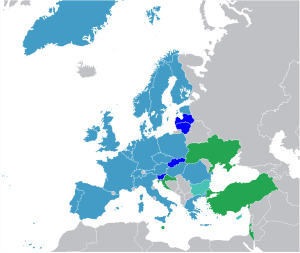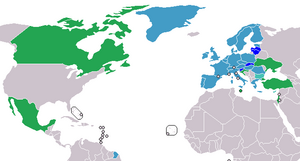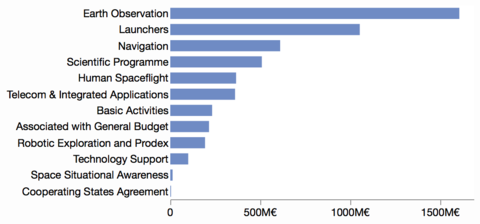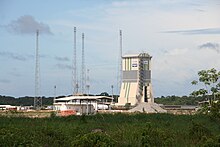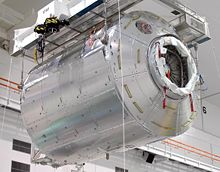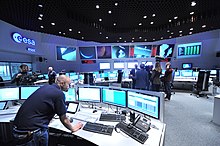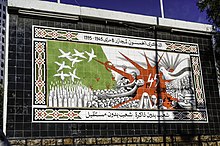 | |

ESA Headquarters in Paris, France
| |
| Abbreviation |
|
|---|---|
| Formation | 30 May 1975 |
| Headquarters | Paris, Île-de-France, France |
Official language
| English, French and German |
Administrator
| Johann-Dietrich Wörner Director General |
| Guiana Space Centre | |
Parent organisation
| |
Budget
| (~US$7.43 billion) (2020) |
| Website | www |
The European Space Agency is an intergovernmental organisation of 22 member states dedicated to the exploration of space. Established in 1975 and headquartered in Paris, ESA has a worldwide staff of about 2,200 in 2018 and an annual budget of about €6.68 billion (~US$7.43 billion) in 2020.
ESA's space flight programme includes human spaceflight (mainly through participation in the International Space Station programme); the launch and operation of uncrewed exploration missions to other planets and the Moon; Earth observation, science and telecommunication; designing launch vehicles; and maintaining a major spaceport, the Guiana Space Centre at Kourou, French Guiana. The main European launch vehicle Ariane 5 is operated through Arianespace with ESA sharing in the costs of launching and further developing this launch vehicle. The agency is also working with NASA to manufacture the Orion Spacecraft service module that will fly on the Space Launch System.
The agency's facilities are distributed among the following centres:
- ESA science missions are based at ESTEC in Noordwijk, Netherlands;
- Earth Observation missions at ESA Centre for Earth Observation in Frascati, Italy;
- ESA Mission Control (ESOC) is in Darmstadt, Germany;
- the European Astronaut Centre (EAC) that trains astronauts for future missions is situated in Cologne, Germany;
- the European Centre for Space Applications and Telecommunications (ECSAT), a research institute created in 2009, is located in Harwell, United Kingdom;
- and the European Space Astronomy Centre (ESAC) is located in Villanueva de la Cañada, Madrid, Spain.
History
Foundation
After World War II, many European scientists left Western Europe in order to work with the United States. Although the 1950s boom made it possible for Western European
countries to invest in research and specifically in space-related
activities, Western European scientists realised solely national
projects would not be able to compete with the two main superpowers. In
1958, only months after the Sputnik shock, Edoardo Amaldi (Italy) and Pierre Auger
(France), two prominent members of the Western European scientific
community, met to discuss the foundation of a common Western European
space agency. The meeting was attended by scientific representatives
from eight countries, including Harrie Massey (United Kingdom).
The Western European nations decided to have two agencies: one concerned with developing a launch system, ELDO (European Launch Development Organization), and the other the precursor of the European Space Agency, ESRO
(European Space Research Organisation). The latter was established on
20 March 1964 by an agreement signed on 14 June 1962. From 1968 to 1972,
ESRO launched seven research satellites.
ESA in its current form was founded with the ESA Convention in
1975, when ESRO was merged with ELDO. ESA had ten founding member
states: Belgium, Denmark, France, West Germany, Italy, the Netherlands, Spain, Sweden, Switzerland, and the United Kingdom.
These signed the ESA Convention in 1975 and deposited the instruments
of ratification by 1980, when the convention came into force. During
this interval the agency functioned in a de facto fashion. ESA launched its first major scientific mission in 1975, Cos-B, a space probe monitoring gamma-ray emissions in the universe, which was first worked on by ESRO.
Later activities
Mock-up of the Ariane 1
ESA collaborated with NASA on the International Ultraviolet Explorer
(IUE), the world's first high-orbit telescope, which was launched in
1978 and operated successfully for 18 years. A number of successful
Earth-orbit projects followed, and in 1986 ESA began Giotto, its first deep-space mission, to study the comets Halley and Grigg–Skjellerup. Hipparcos, a star-mapping mission, was launched in 1989 and in the 1990s SOHO, Ulysses and the Hubble Space Telescope were all jointly carried out with NASA. Later scientific missions in cooperation with NASA include the Cassini–Huygens space probe, to which ESA contributed by building the Titan landing module Huygens.
As the successor of ELDO, ESA has also constructed rockets for scientific and commercial payloads. Ariane 1,
launched in 1979, carried mostly commercial payloads into orbit from
1984 onward. The next two versions of the Ariane rocket were
intermediate stages in the development of a more advanced launch system,
the Ariane 4, which operated between 1988 and 2003 and established ESA as the world leader in commercial space launches in the 1990s. Although the succeeding Ariane 5
experienced a failure on its first flight, it has since firmly
established itself within the heavily competitive commercial space
launch market with 82 successful launches until 2018. The successor
launch vehicle of Ariane 5, the Ariane 6, is under development and is envisioned to enter service in the 2020s.
The beginning of the new millennium saw ESA become, along with agencies like NASA, JAXA, ISRO, the CSA and Roscosmos, one of the major participants in scientific space research.
Although ESA had relied on co-operation with NASA in previous decades,
especially the 1990s, changed circumstances (such as tough legal
restrictions on information sharing by the United States military) led to decisions to rely more on itself and on co-operation with Russia. A 2011 press issue thus stated:
Russia is ESA's first partner in its efforts to ensure long-term access to space. There is a framework agreement between ESA and the government of the Russian Federation on cooperation and partnership in the exploration and use of outer space for peaceful purposes, and cooperation is already underway in two different areas of launcher activity that will bring benefits to both partners.
Notable ESA programs include SMART-1, a probe testing cutting-edge space propulsion technology, the Mars Express and Venus Express missions, as well as the development of the Ariane 5 rocket and its role in the ISS partnership. ESA maintains its scientific and research projects mainly for astronomy-space missions such as Corot, launched on 27 December 2006, a milestone in the search for exoplanets.
On 21 January 2019, ArianeGroup and Arianespace announced a one-year contract with ESA to study and prepare for a mission to mine the Moon for lunar regolith.
Mission
The treaty establishing the European Space Agency reads:
ESA's purpose shall be to provide for, and to promote, for exclusively peaceful purposes, cooperation among the European States in space research and technology and their space applications, with a view to their being used for scientific purposes and for operational space applications systems
ESA is responsible for setting a unified space and related industrial
policy, recommending space objectives to the member states, and
integrating national programs like satellite development, into the
European program as much as possible.
Jean-Jacques Dordain – ESA's Director General (2003–2015) – outlined the European Space Agency's mission in a 2003 interview:
Today space activities have pursued the benefit of citizens, and citizens are asking for a better quality of life on Earth. They want greater security and economic wealth, but they also want to pursue their dreams, to increase their knowledge, and they want younger people to be attracted to the pursuit of science and technology. I think that space can do all of this: it can produce a higher quality of life, better security, more economic wealth, and also fulfill our citizens' dreams and thirst for knowledge, and attract the young generation. This is the reason space exploration is an integral part of overall space activities. It has always been so, and it will be even more important in the future.
Activities and programmes
ESA describes its work in two overlapping ways:
- For the general public, the various fields of work are described as Activities.
- Budgets are organised as Programmes (British spelling retained because it is a term of official documents). These are either Mandatory or Optional.
Activities
According to the ESA website, the activities are:
- Observing the Earth
- Human Spaceflight
- Launchers
- Navigation
- Space Science
- Space Engineering & Technology
- Operations
- Telecommunications & Integrated Applications
- Preparing for the Future
- Space for Climate
Programmes
Mandatory
Every member country must contribute to these programmes:
- Technology Development Element Programme
- Science Core Technology Programme
- General Study Programme
- European Component Initiative
Optional
Depending on their individual choices the countries can contribute to the following programmes, listed according to:
- Launchers
- Earth Observation
- Human Spaceflight and Exploration
- Telecommunications
- Navigation
- Space Situational Awareness
- Technology
ESA_LAB@
ESA
has formed partnerships with universities. ESA_LAB@ refers to research
laboratories at universities. Currently there are ESA_LAB@
- Technische Universität Darmstadt
- École des hautes études commerciales de Paris (HEC Paris)
- Université de recherche Paris Sciences et Lettres
- University of Central Lancashire
Member states, funding and budget
Membership and contribution to ESA
By 2015, ESA was an intergovernmental organisation of 22 member states.
Member states participate to varying degrees in the mandatory (25% of
total expenditures in 2008) and optional space programmes (75% of total
expenditures in 2008). The 2008 budget amounted to €3.0 billion the 2009 budget to €3.6 billion.
The total budget amounted to about €3.7 billion in 2010, €3.99 billion
in 2011, €4.02 billion in 2012, €4.28 billion in 2013, €4.10 billion in
2014 and €4.33 billion in 2015.
English and French are the official languages of the ESA. Additionally,
official documents are also provided in German and documents regarding
the Spacelab
are also provided in Italian. If found appropriate, the agency may
conduct its correspondence in any language of a member state.
The following table lists all the member states and adjunct
members, their ESA convention ratification dates, and their
contributions in 2020:
| Member state/Source | ESA convention | National programme | Contr. (mill. €) |
Contr. (%) |
Contr. per capita (€) |
|---|---|---|---|---|---|
| Austria | 30 December 1986 | FFG | 51.2 | 1.0% | 5.37 |
| Belgium | 3 October 1978 | BELSPO | 210.0 | 4.3% | 17.82 |
| Czech Republic | 12 November 2008 | Ministry of Transport | 44.7 | 0.9% | 3.06 |
| Denmark | 15 September 1977 | DTU Space | 33.8 | 0.7% | 5.47 |
| Estonia | 4 February 2015 | ESO | 3.7 | 0.1% | 1.97 |
| Finland | 1 January 1995 | Business Finland | 27.4 | 0.6% | 3.52 |
| France | 30 October 1980 | CNES | 1,311.7 | 26.9% | 14.30 |
| Germany | 26 July 1977 | DLR | 981.7 | 20.1% | 11.11 |
| Greece | 9 March 2005 | HSA | 20.6 | 0.4% | 0.98 |
| Hungary | 24 February 2015 | HSO | 11.7 | 0.2% | 0.63 |
| Ireland | 10 December 1980 | EI | 24.8 | 0.5% | 3.60 |
| Italy | 20 February 1978 | ASI | 665.8 | 13.7% | 7.77 |
| Luxembourg | 30 June 2005 | Luxinnovation | 29.9 | 0.6% | 44.19 |
| Netherlands | 6 February 1979 | NSO | 100.3 | 2.1% | 5.32 |
| Norway | 30 December 1986 | NSA | 86.3 | 1.8% | 12.09 |
| Poland | 19 November 2012 | POLSA | 38.4 | 0.8% | 0.91 |
| Portugal | 14 November 2000 | FCT | 21.0 | 0.4% | 1.77 |
| Romania | 22 December 2011 | ROSA | 34.3 | 0.7% | 2.18 |
| Spain | 7 February 1979 | INTA | 249.5 | 5.1% | 4.39 |
| Sweden | 6 April 1976 | SNSA | 83.2 | 1.7% | 7.15 |
| Switzerland | 19 November 1976 | SSO | 167.0 | 3.4% | 17.61 |
| United Kingdom | 28 March 1978 | UKSA | 464.3 | 9.5% | 5.05 |
| Other | — | — | 181.3 | 3.7% |
|
| Non-full members |
|
| |||
| 1 January 1979 | CSA | 28.0 | 0.6% | 0.53 | |
| Slovenia | 5 July 2016 | SPACE-SI | 3.2 | 0.1% | 1.31 |
| Total members and associates | 4,870.0 | 100% |
| ||
| European Union | 28 May 2004 | ESP | 1,683.3 | 93.0% | 2.56 |
| EUMETSAT | — | — | 54.3 | 3.0% |
|
| Other income | — | — | 72.4 | 4.0% |
|
| Total other institutional partners | 1,810.0 | 100% |
| ||
| Total ESA | 6,680.0 |
|
|
Non-full member states
Slovenia
Currently the only associated member state is Slovenia. Previously associated members were Austria, Norway and Finland, all of which later joined ESA as full members.
Canada
Since 1 January 1979, Canada has had the special status of a Cooperating State within ESA. By virtue of this accord, the Canadian Space Agency
takes part in ESA's deliberative bodies and decision-making and also in
ESA's programmes and activities. Canadian firms can bid for and receive
contracts to work on programmes. The accord has a provision ensuring a
fair industrial return to Canada. The most recent Cooperation Agreement was signed on 15 December 2010 with a term extending to 2020. For 2014, Canada's annual assessed contribution to the ESA general budget was €6,059,449 (CAD$8,559,050). For 2017, Canada has increased its annual contribution to €21,600,000 (CAD$30,000,000).
Budget appropriation and allocation
European Space Agency 2016 budget by domain out of a total budget is 5250M€.
ESA is funded from annual contributions by national governments as well as from an annual contribution by the European Union (EU).
The budget of ESA was €5.250 billion in 2016.
Every 3–4 years, ESA member states agree on a budget plan for several
years at an ESA member states conference. This plan can be amended in
future years, however provides the major guideline for ESA for several
years. The 2016 budget allocations for major areas of ESA activity are shown in the chart on the right.
Countries typically have their own space programmes that differ
in how they operate organisationally and financially with ESA. For
example, the French space agency CNES has a total budget of €2015
million, of which €755 million is paid as direct financial contribution
to ESA. Several space-related projects are joint projects between national space agencies and ESA (e.g. COROT). Also, ESA is not the only European governmental space organisation (for example European Union Satellite Centre).
Enlargement
After the decision of the ESA Council of 21/22 March 2001, the procedure for accession of the European states was detailed as described the document titled "The Plan for European Co-operating States (PECS)".
Nations that want to become a full member of ESA do so in 3 stages.
First a Cooperation Agreement is signed between the country and ESA. In
this stage, the country has very limited financial responsibilities. If a
country wants to co-operate more fully with ESA, it signs a European
Cooperating State (ECS) Agreement. The ECS Agreement makes companies
based in the country eligible for participation in ESA procurements. The
country can also participate in all ESA programmes, except for the
Basic Technology Research Programme. While the financial contribution of
the country concerned increases, it is still much lower than that of a
full member state. The agreement is normally followed by a Plan For
European Cooperating State (or PECS Charter). This is a 5-year programme
of basic research and development activities aimed at improving the
nation's space industry capacity. At the end of the 5-year period, the
country can either begin negotiations to become a full member state or
an associated state or sign a new PECS Charter. Many countries, most of which joined the EU in both 2004 and 2007, have started to co-operate with ESA on various levels.
During the Ministerial Meeting in December 2014, ESA ministers
approved a resolution calling for discussions to begin with Israel,
Australia and South Africa on future association agreements. The
ministers noted that "concrete cooperation is at an advanced stage" with
these nations and that "prospects for mutual benefits are existing".
A separate space exploration strategy resolution calls for
further co-operation with the United States, Russia and China on "LEO
exploration, including a continuation of ISS cooperation and the
development of a robust plan for the coordinated use of space
transportation vehicles and systems for exploration purposes,
participation in robotic missions for the exploration of the Moon, the
robotic exploration of Mars, leading to a broad Mars Sample Return
mission in which Europe should be involved as a full partner, and human
missions beyond LEO in the longer term."
EU and the European Space Agency
The political perspective of the European Union (EU) was to make ESA an agency of the EU by 2014,
although this date was not met. The EU is already the largest single
donor to ESA's budget and non-ESA EU states are observers at ESA.
Launch vehicle fleet
ESA
has a fleet of different launch vehicles in service with which it
competes in all sectors of the launch market. ESA's fleet consists of
three major rocket designs: Ariane 5, Soyuz-2 and Vega. Rocket launches are carried out by Arianespace, which has 23 shareholders representing the industry that manufactures the Ariane 5 as well as CNES, at ESA's Guiana Space Centre.
Because many communication satellites have equatorial orbits, launches
from French Guiana are able to take larger payloads into space than from
spaceports at higher latitudes. In addition, equatorial launches give spacecraft an extra 'push' of nearly 500 m/s due to the higher rotational velocity of the Earth at the equator compared to near the Earth's poles where rotational velocity approaches zero.
Ariane 5
The Ariane 5 rocket is ESA's primary launcher. It has been in service since 1997 and replaced Ariane 4. Two different variants are currently in use. The heaviest and most used version, the Ariane 5 ECA, delivers two communications satellites of up to 10 tonnes into GTO. It failed during its first test flight in 2002, but has since made 82 consecutive successful flights until a partial failure in January 2018. The other version, Ariane 5 ES, was used to launch the Automated Transfer Vehicle (ATV) to the International Space Station (ISS) and will be used to launch four Galileo navigational satellites at a time.
In November 2012, ESA agreed to build an upgraded variant called Ariane 5 ME
(Mid-life Evolution) which would increase payload capacity to 11.5
tonnes to GTO and feature a restartable second stage to allow more
complex missions. Ariane 5 ME was scheduled to fly in 2018, but the whole project was scrapped in favor of Ariane 6, planned to replace Ariane 5 in the 2020s.
ESA's Ariane 1, 2, 3 and 4 launchers (the last of which was ESA's long-time workhorse) have been retired.
Soyuz
Soyuz-2 (also called the Soyuz-ST or Soyuz-STK) is a Russian medium payload launcher (ca. 3 metric tons to GTO) which was brought into ESA service in October 2011. ESA entered into a €340 million joint venture with the Russian Federal Space Agency over the use of the Soyuz launcher.
Under the agreement, the Russian agency manufactures Soyuz rocket parts
for ESA, which are then shipped to French Guiana for assembly.
ESA benefits because it gains a medium payload launcher,
complementing its fleet while saving on development costs. In addition,
the Soyuz rocket—which has been the Russian's space launch workhorse for
more than 50 years—is proven technology with a very good safety record.
Russia benefits in that it gets access to the Kourou launch site. Due
to its proximity to the equator, launching from Kourou rather than Baikonur nearly doubles Soyuz's payload to GTO (3.0 tonnes vs. 1.7 tonnes).
Soyuz first launched from Kourou on 21 October 2011, and successfully placed two Galileo satellites into orbit 23,222 kilometres above Earth.
Vega
Vega rocket
Vega is ESA's carrier for small satellites. Developed by seven ESA members led by Italy, it is capable of carrying a payload with a mass of between 300 and 1500 kg to an altitude of 700 km, for low polar orbit. Its maiden launch from Kourou was on 13 February 2012. Vega began full commercial exploitation in December 2015.
The rocket has three solid propulsion stages and a liquid propulsion upper stage (the AVUM) for accurate orbital insertion and the ability to place multiple payloads into different orbits.
Ariane launch vehicle development funding
Historically,
the Ariane family rockets have been funded primarily "with money
contributed by ESA governments seeking to participate in the program
rather than through competitive industry bids. This [has meant that]
governments commit multiyear funding to the development with the
expectation of a roughly 90% return on investment in the form of
industrial workshare." ESA is proposing changes to this scheme by
moving to competitive bids for the development of the Ariane 6.
Human space flight
History
Ulf Merbold became the first ESA astronaut to fly into space.
At the time ESA was formed, its main goals did not encompass human
space flight; rather it considered itself to be primarily a scientific
research organisation for uncrewed space exploration in contrast to its
American and Soviet counterparts. It is therefore not surprising that
the first non-Soviet European in space was not an ESA astronaut on a
European space craft; it was Czechoslovak Vladimír Remek who in 1978 became the first non-Soviet or American in space (the first man in space being Yuri Gagarin of the Soviet Union) – on a Soviet Soyuz spacecraft, followed by the Pole Mirosław Hermaszewski and East German Sigmund Jähn in the same year. This Soviet co-operation programme, known as Intercosmos, primarily involved the participation of Eastern bloc countries. In 1982, however, Jean-Loup Chrétien became the first non-Communist Bloc astronaut on a flight to the Soviet Salyut 7 space station.
Because Chrétien did not officially fly into space as an ESA astronaut, but rather as a member of the French CNES astronaut corps, the German Ulf Merbold is considered the first ESA astronaut to fly into space. He participated in the STS-9 Space Shuttle mission that included the first use of the European-built Spacelab
in 1983. STS-9 marked the beginning of an extensive ESA/NASA joint
partnership that included dozens of space flights of ESA astronauts in
the following years. Some of these missions with Spacelab were fully
funded and organizationally and scientifically controlled by ESA (such
as two missions by Germany and one by Japan) with European astronauts as
full crew members rather than guests on board. Beside paying for
Spacelab flights and seats on the shuttles, ESA continued its human
space flight co-operation with the Soviet Union and later Russia, including numerous visits to Mir.
During the latter half of the 1980s, European human space flights
changed from being the exception to routine and therefore, in 1990, the
European Astronaut Centre in Cologne,
Germany was established. It selects and trains prospective astronauts
and is responsible for the co-ordination with international partners,
especially with regard to the International Space Station.
As of 2006, the ESA astronaut corps officially included twelve members,
including nationals from most large European countries except the
United Kingdom.
In the summer of 2008, ESA started to recruit new astronauts so
that final selection would be due in spring 2009. Almost 10,000 people
registered as astronaut candidates before registration ended in June
2008. 8,413 fulfilled the initial application criteria. Of the
applicants, 918 were chosen to take part in the first stage of
psychological testing, which narrowed down the field to 192. After
two-stage psychological tests and medical evaluation in early 2009, as
well as formal interviews, six new members of the European Astronaut Corps were selected – five men and one woman.
Astronaut names
The astronauts of the European Space Agency are:
- France Jean-François Clervoy
- Italy Samantha Cristoforetti
- Belgium Frank De Winne
- Spain Pedro Duque
- Germany Reinhold Ewald
- France Léopold Eyharts
- Germany Alexander Gerst
- Italy Umberto Guidoni
- Sweden Christer Fuglesang
- Netherlands André Kuipers
- Germany Matthias Maurer
- Denmark Andreas Mogensen
- Italy Paolo Nespoli
- Switzerland Claude Nicollier
- Italy Luca Parmitano
- United Kingdom Timothy Peake
- France Philippe Perrin
- France Thomas Pesquet
- Germany Thomas Reiter
- Germany Hans Schlegel
- Germany Gerhard Thiele
- France Michel Tognini
- Italy Roberto Vittori
In
the 1980s, France pressed for an independent European crew launch
vehicle. Around 1978 it was decided to pursue a reusable spacecraft
model and starting in November 1987 a project to create a mini-shuttle
by the name of Hermes was introduced. The craft was comparable to early proposals for the Space Shuttle
and consisted of a small reusable spaceship that would carry 3 to 5
astronauts and 3 to 4 metric tons of payload for scientific experiments.
With a total maximum weight of 21 metric tons it would have been
launched on the Ariane 5 rocket, which was being developed at that time. It was planned solely for use in low Earth orbit
space flights. The planning and pre-development phase concluded in
1991; the production phase was never fully implemented because at that
time the political landscape had changed significantly. With the fall of
the Soviet Union
ESA looked forward to co-operation with Russia to build a
next-generation space vehicle. Thus the Hermes programme was cancelled
in 1995 after about 3 billion dollars had been spent. The Columbus space station programme had a similar fate.
In the 21st century, ESA started new programmes in order to
create its own crew vehicles, most notable among its various projects
and proposals is Hopper, whose prototype by EADS, called Phoenix, has already been tested. While projects such as Hopper
are neither concrete nor to be realised within the next decade, other
possibilities for human spaceflight in co-operation with the Russian Space Agency have emerged. Following talks with the Russian Space Agency in 2004 and June 2005, a co-operation between ESA and the Russian Space Agency was announced to jointly work on the Russian-designed Kliper,
a reusable spacecraft that would be available for space travel beyond
LEO (e.g. the moon or even Mars). It was speculated that Europe would
finance part of it. A €50 million participation study for Kliper, which
was expected to be approved in December 2005, was finally not approved
by the ESA member states. The Russian state tender for the project was
subsequently cancelled in 2006.
In June 2006, ESA member states granted 15 million to the Crew Space Transportation System (CSTS) study, a two-year study to design a spacecraft capable of going beyond Low-Earth orbit based on the current Soyuz design. This project was pursued with Roskosmos
instead of the cancelled Kliper proposal. A decision on the actual
implementation and construction of the CSTS spacecraft was contemplated
for 2008.
In mid-2009 EADS Astrium was awarded a €21 million study into designing a
crew vehicle based on the European ATV which is believed to now be the
basis of the Advanced Crew Transportation System design.
In November 2012, ESA decided to join NASA's Orion programme.
The ATV would form the basis of a propulsion unit for NASA's new crewed
spacecraft. ESA may also seek to work with NASA on Orion's launch
system as well in order to secure a seat on the spacecraft for its own
astronauts.
In September 2014, ESA signed an agreement with Sierra Nevada Corporation for co-operation in Dream Chaser project. Further studies on the Dream Chaser for European Utilization or DC4EU project were funded, including the feasibility of launching a Europeanized Dream Chaser onboard Ariane 5.
Cooperation with other countries and organisations
ESA
has signed co-operation agreements with the following states that
currently neither plan to integrate as tightly with ESA institutions as
Canada, nor envision future membership of ESA: Argentina, Brazil, China, India (for the Chandrayan mission), Russia and Turkey.
Additionally, ESA has joint projects with the European Union, NASA of the United States and is participating in the International Space Station together with the United States (NASA), Russia and Japan (JAXA).
European Union
ESA and EU member states
ESA-only members
EU-only members
ESA is not an agency or body of the European Union
(EU), and has non-EU countries (Norway, Switzerland, and the United
Kingdom) as members. There are however ties between the two, with
various agreements in place and being worked on, to define the legal
status of ESA with regard to the EU.
There are common goals between ESA and the EU. ESA has an EU
liaison office in Brussels. On certain projects, the EU and ESA
co-operate, such as the upcoming Galileo satellite navigation system. Space policy has since December 2009 been an area for voting in the European Council. Under the European Space Policy of 2007,
the EU, ESA and its Member States committed themselves to increasing
co-ordination of their activities and programmes and to organising their
respective roles relating to space.
The Lisbon Treaty of 2009 reinforces the case for space in Europe
and strengthens the role of ESA as an R&D space agency. Article 189
of the Treaty gives the EU a mandate to elaborate a European space
policy and take related measures, and provides that the EU should
establish appropriate relations with ESA.
Former Italian astronaut Umberto Guidoni, during his tenure as a Member of the European Parliament
from 2004 to 2009, stressed the importance of the European Union as a
driving force for space exploration, "since other players are coming up
such as India and China it is becoming ever more important that
Europeans can have an independent access to space. We have to invest
more into space research and technology in order to have an industry
capable of competing with other international players."
The first EU-ESA International Conference on Human Space Exploration took place in Prague on 22 and 23 October 2009.
A road map which would lead to a common vision and strategic planning
in the area of space exploration was discussed. Ministers from all 29 EU
and ESA members as well as members of parliament were in attendance.
National space organisations of member states
- The Centre National d'Études Spatiales (CNES) (National Centre for Space Study) is the French government space agency (administratively, a "public establishment of industrial and commercial character"). Its headquarters are in central Paris. CNES is the main participant on the Ariane project. Indeed, CNES designed and tested all Ariane family rockets (mainly from its centre in Évry near Paris)
- The UK Space Agency is a partnership of the UK government departments which are active in space. Through the UK Space Agency, the partners provide delegates to represent the UK on the various ESA governing bodies. Each partner funds its own programme.
- The Italian Space Agency (Agenzia Spaziale Italiana or ASI) was founded in 1988 to promote, co-ordinate and conduct space activities in Italy. Operating under the Ministry of the Universities and of Scientific and Technological Research, the agency cooperates with numerous entities active in space technology and with the president of the Council of Ministers. Internationally, the ASI provides Italy's delegation to the Council of the European Space Agency and to its subordinate bodies.
- The German Aerospace Center (DLR) (German: Deutsches Zentrum für Luft- und Raumfahrt e. V.) is the national research centre for aviation and space flight of the Federal Republic of Germany and of other member states in the Helmholtz Association. Its extensive research and development projects are included in national and international cooperative programmes. In addition to its research projects, the centre is the assigned space agency of Germany bestowing headquarters of German space flight activities and its associates.
- The Instituto Nacional de Técnica Aeroespacial (INTA) (National Institute for Aerospace Technique) is a Public Research Organization specialised in aerospace research and technology development in Spain. Among other functions, it serves as a platform for space research and acts as a significant testing facility for the aeronautic and space sector in the country.
NASA
ESA has a long history of collaboration with NASA. Since ESA's astronaut corps was formed, the Space Shuttle
has been the primary launch vehicle used by ESA's astronauts to get
into space through partnership programmes with NASA. In the 1980s and
1990s, the Spacelab
programme was an ESA-NASA joint research programme that had ESA develop
and manufacture orbital labs for the Space Shuttle for several flights
on which ESA participate with astronauts in experiments.
In robotic science mission and exploration missions, NASA has been ESA's main partner. Cassini–Huygens was a joint NASA-ESA mission, along with the Infrared Space Observatory, INTEGRAL, SOHO, and others. Also, the Hubble Space Telescope is a joint project of NASA and ESA. Future ESA-NASA joint projects include the James Webb Space Telescope and the proposed Laser Interferometer Space Antenna. NASA has committed to provide support to ESA's proposed MarcoPolo-R mission to return an asteroid sample to Earth for further analysis. NASA and ESA will also likely join together for a Mars Sample Return Mission.
Cooperation with other space agencies
Since China has started to invest more money into space activities, the Chinese Space Agency has sought international partnerships. ESA is, beside the Russian Space Agency, one of its most important partners. Two space agencies cooperated in the development of the Double Star Mission. In 2017, ESA sent two astronauts to China for two weeks sea survival training with Chinese astronauts in Yantai, Shandong.
ESA entered into a major joint venture with Russia in the form of the CSTS, the preparation of French Guiana spaceport for launches of Soyuz-2 rockets and other projects. With India, ESA agreed to send instruments into space aboard the ISRO's Chandrayaan-1 in 2008. ESA is also co-operating with Japan, the most notable current project in collaboration with JAXA is the BepiColombo mission to Mercury.
Speaking to reporters at an air show near Moscow in August 2011,
ESA head Jean-Jacques Dordain said ESA and Russia's Roskosmos space
agency would "carry out the first flight to Mars together."
International Space Station
ISS module Columbus at Kennedy Space Center's Space Station Processing Facility
With regard to the International Space Station (ISS) ESA is not represented by all of its member states:
10 of the 21 ESA member states currently participate in the project:
Belgium, Denmark, France, Germany, Italy, Netherlands, Norway, Spain,
Sweden and Switzerland. Austria, Finland and Ireland chose not to
participate, because of lack of interest or concerns about the expense
of the project. The United Kingdom withdrew from the preliminary agreement
because of concerns about the expense of the project. Portugal,
Luxembourg, Greece, the Czech Republic, Romania and Poland joined ESA
after the agreement had been signed. ESA is taking part in the
construction and operation of the ISS with contributions such as Columbus, a science laboratory module that was brought into orbit by NASA's STS-122 Space Shuttle mission and the Cupola observatory module that was completed in July 2005 by Alenia Spazio
for ESA. The current estimates for the ISS are approaching €100 billion
in total (development, construction and 10 years of maintaining the
station) of which ESA has committed to paying €8 billion.
About 90% of the costs of ESA's ISS share will be contributed by
Germany (41%), France (28%) and Italy (20%). German ESA astronaut Thomas Reiter was the first long-term ISS crew member.
ESA has developed the Automated Transfer Vehicle for ISS resupply. Each ATV has a cargo capacity of 7,667 kilograms (16,903 lb). The first ATV, Jules Verne,
was launched on 9 March 2008 and on 3 April 2008 successfully docked
with the ISS. This manoeuvre, considered a major technical feat,
involved using automated systems to allow the ATV to track the ISS,
moving at 27,000 km/h, and attach itself with an accuracy of 2 cm.
As of 2013, the spacecraft establishing supply links to the ISS are the Russian Progress and Soyuz, European ATV, Japanese Kounotori (HTV), and the USA COTS program vehicles Dragon and Cygnus.
European Life and Physical Sciences research on board the International Space Station (ISS) is mainly based on the European Programme for Life and Physical Sciences in Space programme that was initiated in 2001.
Languages
According to Annex 1, Resolution No. 8 of the ESA Convention and Council Rules of Procedure,
English, French and German may be used in all meetings of the Agency,
with interpretation provided into these three languages. All official
documents are available in English and French with all documents
concerning the ESA Council being available in German as well.
Facilities
- ESA Headquarters (HQ), Paris, France
- European Space Operations Centre (ESOC), Darmstadt, Germany
- European Space Research and Technology Centre (ESTEC), Noordwijk, The Netherlands
- European Space Astronomy Centre (ESAC), Madrid, Spain
- European Centre for Space Applications and Telecommunications (ECSAT), Oxfordshire, United Kingdom
- European Astronaut Centre (EAC), Cologne, Germany
- ESA Centre for Earth Observation (ESRIN), Frascati, Italy
- Guiana Space Centre (CSG), Kourou, French Guiana
- European Space Tracking Network (ESTRACK)
- European Data Relay System
ESA and the EU institutions
The Flag of Europe is the one to be flown in space during missions (for example it was flown by ESA's Andre Kuipers during Delta mission).
The Commission
is increasingly working together towards common objectives. Some 20 per
cent of the funds managed by ESA now originate from the supranational budget of the European Union.
In recent years the ties between ESA and the European institutions have
been reinforced by the increasing role that space plays in supporting
Europe's social, political and economic policies.
The legal basis for the EU/ESA co-operation is provided by a
Framework Agreement which entered into force in May 2004. According to
this agreement, the European Commission and ESA co-ordinate their
actions through the Joint Secretariat, a small team of EC's
administrators and ESA executive. The Member States of the two
organisations meet at ministerial level in the Space Council, which is a
concomitant meeting of the EU and ESA Councils, prepared by Member
States representatives in the High-level Space Policy Group (HSPG).
ESA maintains a liaison office in Brussels to facilitate relations with the European institutions.
Guaranteeing European access to space
In
May 2007, the 29 European countries expressed their support for the
European Space Policy in a resolution of the Space Council, unifying the
approach of ESA with those of the European Union and their member
states.
Prepared jointly by the European Commission and ESA's Director
General, the European Space Policy sets out a basic vision and strategy
for the space sector and addresses issues such as security and defence,
access to space and exploration.
Through this resolution, the EU, ESA and their Member States all
commit to increasing co-ordination of their activities and programmes
and their respective roles relating to space.


